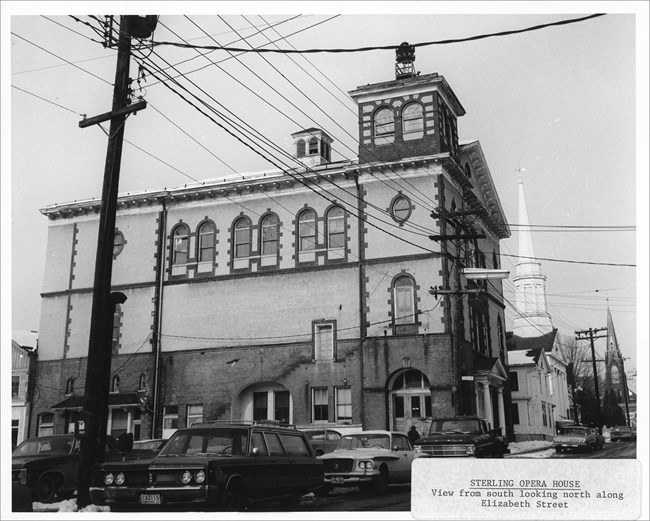
Image courtesy of the Connecticut State Historic Preservation Office
Celebrate Preservation Month 2025: The Power of Place!
On May 9, 2025, the National Register of Historic Places reached over 100,000 listings, a testament to decades of dedication to preserving America's rich architectural, historical, and cultural heritage by Federal, state, and local agencies, in partnership with Tribes, public and private organizations, and individuals. To celebrate this incredible achievement, the National Register is showcasing early icons that shaped historic preservation alongside newly recognized treasures that continue to inspire its future.
Preservation Month, established in 1973 by the National Trust for Historic Preservation, is a time when communities across the country recognize the importance of their historic places. Many events promote historic places to instill national and community pride, promote heritage tourism, and showcase the social and economic benefits of historic preservation. By celebrating Preservation Month, communities honor the power of these places and reaffirm their commitment to protecting them.
Visit a historic place near you with our Heritage Travel Itineraries
Learn more about a historic place near you with Teaching with Historic Places
See if your State Historic Preservation Office has events planned
Take part in the National Trust's campaign
Find out more about Historic Preservation
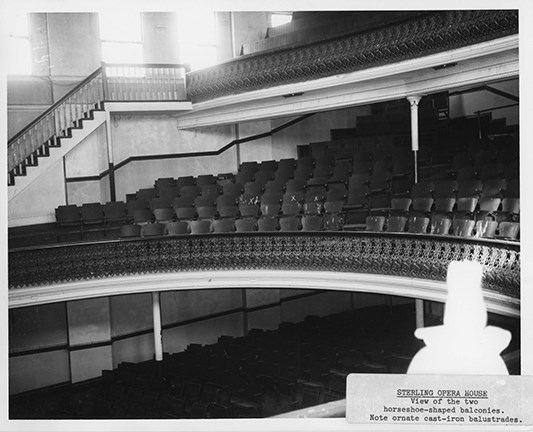
Image courtesy of the Connecticut State Historic Preservation Office
Sterling Opera House, an individual property listed in 1968
The 1889 Sterling Opera House in Derby, Connecticut, is one of the earliest listings in the National Register of an individual property submitted by a State Historic Preservation Officer. It is described in the 1968 nomination as a "bold and dramatic building" whose "scale and mass make it a dominant feature of the square and it should remain as a focal center for subsequent town planning; it can serve in any number of adaptive uses and deserves preservation for purely practical terms equally as much as for architectural terms." The Sterling Opera House's enduring presence not only celebrates architectural grandeur but also underscores the National Register's role in supporting thoughtful community development.Link to file
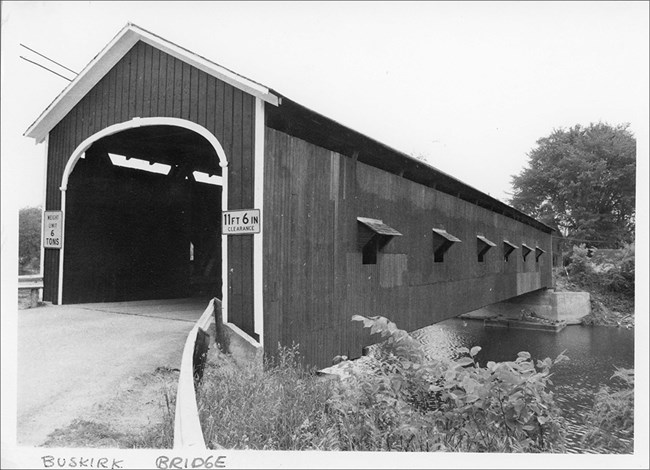
Image courtesy of the New York State Historic Preservation Office, photograph by Robert Raymond, 1976
Covered Bridges of Washington County, a Multiple Property Documentation Form approved in 1978
"Covered Bridges of Washington County" is one of the earliest Multiple Property Documentation Forms (MPDF, or "cover") included in the National Register. An MPDF is not a nomination but rather a tool for recognizing related historic properties and guiding preservation efforts with both vision and precision. It provides the context for evaluating thematically-related historic properties and establishes the registration requirements for properties that may be nominated in the future.
Approved in 1978, this MPDF discusses the wooden covered bridge as a 19th-century structural type in Washington County, New York. Four covered bridges are identified and each is documented through an individual listing.
Link to MPDF
78003457 Buskirk Covered Bridge
78003458 Eagleville Covered Bridge
78003459 Rexleigh Covered Bridge
78003460 Shushan Covered Bridge
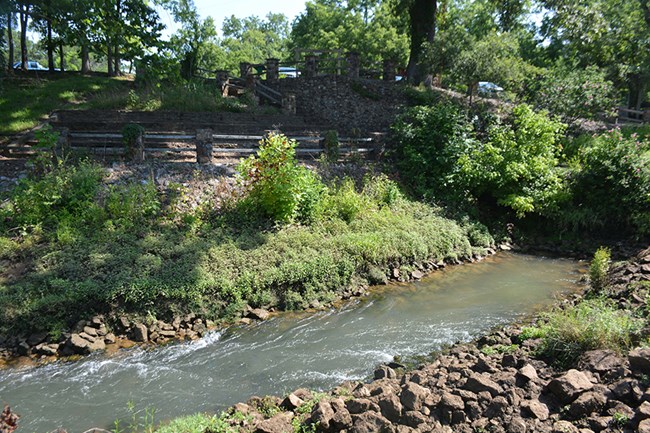
Image courtesy of Arkansas State Historic Preservation Office, photograph by Ralph S. Wilcox, 2024
Big Spring, an individual property listed in 2025
Big Spring in Bull Shoals, Arkansas, features a six-level curved fieldstone terrace alongside a natural spring. The terrace is accessed from fieldstone steps abutting a sizeable fieldstone retaining wall. Thoughtfully designed railings of stone and wood provide visual continuity throughout. The structure, located within the 732-acre Big Spring Park, was built through the "Green Thumb" program established as the result of several Johnson Administration initiatives in 1965.
Big Spring is one of several recent listings (as of May 9, 2025) that pushed the total number of listings in the National Register over the 100,000 mark. At Big Spring, the built and natural environments are intertwined to create a place worthy of preservation.
Link to file
Featured Historic Properties from Past Preservation Months
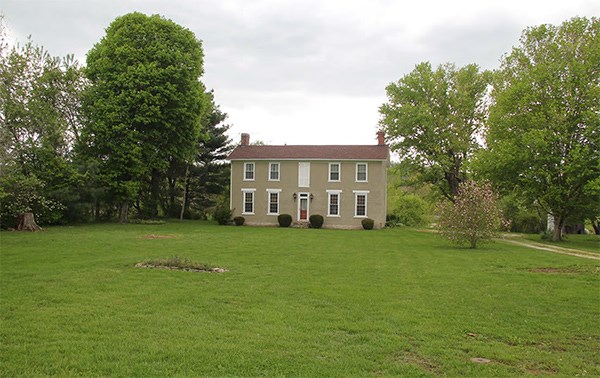
Photograph by Catherine Bache, courtesy of the Kentucky State Historic Preservation Office
Brewing in Chicago began with the arrival of William Haas and Andrew Sulzer from Watertown, New York, establishing the city's first brewery in 1833. Brewers soon established their own management systems for taverns and saloons that were “tied” to the brand, including renting commercial property, and designing, developing, and building taverns of their own. The tied House came to Chicago in 1892, when the Chicago Brewing & Malting Company and the Milwaukee & Chicago Breweries Ltd. began buying existing saloons and acquiring land to build taverns on. The form of the tied house is based on a simple “store and flat” building, with the public/retail space on the first floor, and private/residential space on the second or even third or fourth story.
Barnum Museum, Bridgeport, Connecticut
The Barnum Museum in Bridgeport, Connecticut, listed in the National Register in 1972 (with more information added in 2010), is a massive Romanesque Revival style masonry building designed and constructed by Longstaff and Hurd of Bridgeport in 1893 at the bequest of the nationally renowned entertainment entrepreneur, Phineas Taylor Barnum. Barnum approved the plans for its construction three weeks before his death on April 7, 1891. In 2021, the Barnum Museum received a Save America's Treasures (SAT) grant to repair 79 windows.
Read more on the SAT Grant
Sroufe House, Dover, Kentucky
The documentation, prepared by a Girl Scout, highlights the role the house played in the escape of three enslaved people owned by the Sroufe family. Noted Underground Railroad “conductor” John P. Parker, a free African American man living across the river in Ohio, helped Celia Brooks, her husband, and baby escape bondage and cross the river to freedom.
Iowa Tribe Community Building, White Cloude, Kansas
completed in 1940 on tribal lands of the Iowa Tribe of Kansas and Nebraska reservation, about five miles west of White Cloud. The building was constructed by tribal members as part of the New Deal-era Civilian Conservation Corps' Indian Division (CCC-ID), a subset of the Works Progress Administration (WPA). The building has served the needs of the Iowa Tribe community over the years as a meeting place for cultural and social events, dances, powwows, funerals, feasts, religious services, social programs, tribal government meetings, and administration.
North Hampton Town Hall, Rockingham County, New Hampshire
Built in 1844, and moved to its present location at 231 Atlantic Avenue in 1886, the historic single-story, clapboarded building set on a foundation of granite blocks, owes its listing to the work of local residents, starting with a Winnacunnet High School senior project in 2006. Noticing the North Hampton Town Hall was in a state of disrepair, Kathy Shea did her Winnacunnet High School senior project on researching the history of the building and placing it on the New Hampshire Register of Historic Places, administered by the New Hampshire Division of Historical Resources. The North Hampton Town Hall was condemned in 2004 due to its lack of structural integrity. Beginning with Kathy Shea’s research in recent years, attention was drawn to repairing the North Hampton Tall Hall. In 2010 the town embarked on a multi-year renovation project which included new bathrooms, a handicapped access ramp in back, a new front porch, restoration for the windows and the installation of storm windows. The renovated building is now used for municipal meetings, voting and a variety of community functions. The Town Hall Recreation Department and the Cable television station also have offices in this building.
Akron Opera House, Plymouth County, Iowa
Opening in the spring of 1906, the Akron Opera House embodies the heyday of rural community opera houses (1890-early 1940s), when opera houses were built all across Iowa and the Midwest as rural communities developed places to house cultural activities. During 1906-1938, the Akron Opera House was the central meeting place and entertainment venue for the entire community. Because of its size and optimum location it was an integral fixture in the community: the Akron High School held its commencement exercises in the theatre, Carrie Nation, the famous hatchet wielding, temperance crusader, was booked for a presentation in 1910, traveling plays and concerts were presented through the 1920s, dances, moving picture shows, church bazaars, declamation concerts, basketball games, political speeches, wrestling matches, revival meetings, and federal court witness interviews were presented or conducted until the late 1930s.
Chicano Park, San Diego, California
Chicano Park, in San Diego, California, was the site of a powerful protest in 1970 by members of the local San Diego Hispanic community over the planned redevelopment of a vacant site within the Barrio Logan community that had been previously promised to the community as public open space. The peaceful occupation of the site and the subsequent successful struggle to turn the location into a vibrant community gathering spot is closely associated with the local Chicano Civil Rights Movement in San Diego.
South Carolina Memorial Garden, Columbia, Richland County, South Carolina
It took almost a decade, but the preservation efforts to repair the South Carolina Memorial Garden, in Columbia, Richland County, South Carolina, paid off. In 2000 an ice storm in South Carolina inflicted heavy damage on the trees and shrubs that were the living history of American landscape architect Loutrel W. Briggs’ vision for the landscape of the South Carolina Memorial Garden. The members of the Garden Club of South Carolina initiated an extensive restoration of the garden’s plantings, structures, and hardscapes in 2003 under the guidance of Atlanta landscape architect James R. Cothran (an expert on Briggs' work) of Robert and Company. Cothran’s efforts during a restoration undertaken in 2007-2008 and dedicated in April 2009 have adhered to Briggs’ original scheme in order to maintain the property’s historic integrity.
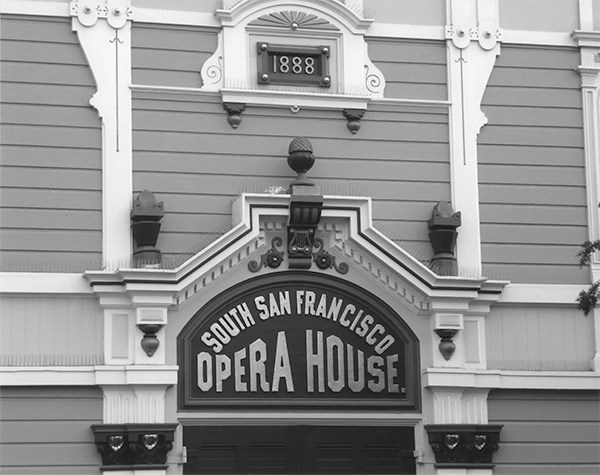
Photograph by Matthew Davis/Katherine Petrin, Architectural Resources Group, courtesy of California State Historic Preservation Office
Now known as the Bay View Opera House, this opera house was built in 1888. the building served as a public social hall for gatherings, cultural events and entertainment. The Opera House was the first cultural building constructed in the neighborhood and served for decades as the chief social center of the Bayview-Hunters Point district, regularly hosting dances, fairs, political rallies, and charity benefits.
San Timoteo Canyon Schoolhouse, Redlands, Riverside County, California
Follow the history of this rural one room schoolhouse from its construction in the 1890s to its rehabilitation in 2008 to become a county interpretive center.
A. Quinn Jones House, Gainesville, Alachua County, Florida
The house of this extraordinary man has been renovated and turned into a community center. Quinn was a teacher to his community and so much more. Read about his life, his career, and the communities he touched.
Moon-Randolph Ranch, Missoula County, Montana
The story of this ranch parallels the story of Montana. Read how Ray and Luella Moon established a "claim shack" and what happened to the ranch through generations. The Moon-Randolph Ranch will continue to tell the story of Montana because the City of Missoula acquired the ranch, and it is currently used for living history activities.
Downtown Churches Historic District, Sheboygan, Sheyboygan County, Wisconsin
The Downtown Churches Historic District is a well defined cluster of religious buildings. The four congregations located in the district represent four distinct faiths, each with a medium-sized, well-designed, and well-maintained church building.
Marie Webster House, Marion, IN
Marie Webster made quilts during the first half of the 20th century, and represents a shift from the traditional designs to modern designs inspired by the Arts and Crafts Movement. She also wrote the path breaking book Quilts: Their Story and How to Make Them, which was the first book solely dedicated to the history of the quilt.
Woodlawn, Alexandria, VA
Explore the former home of George Washington's adopted daughter, a National Trust for Historic Preservation property since 1951.
The Quincy Homestead (1686-1904) is a remarkable example of New England architecture and its transformations from the late seventeenth century to the late nineteenth century.
The Subway Terminal Building, Los Angeles, Los Angeles, CA
Now called the Metro 17, the building won a 2006 Preservation Award from the Los Angeles Conservancy for its role in the revitalization of downtown L.A. The estimated rehabilitation costs for this project were $55,175,744.
Newport Historic District, Rhode Island
Newport’s era of greatest prosperity was from 1740 to 1775, and numerous surviving structures date from those golden years. The prosperity was undermined by the American Revolution and the British army...
Last updated: May 14, 2025
